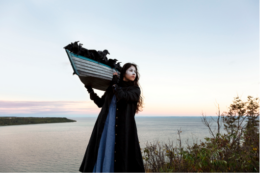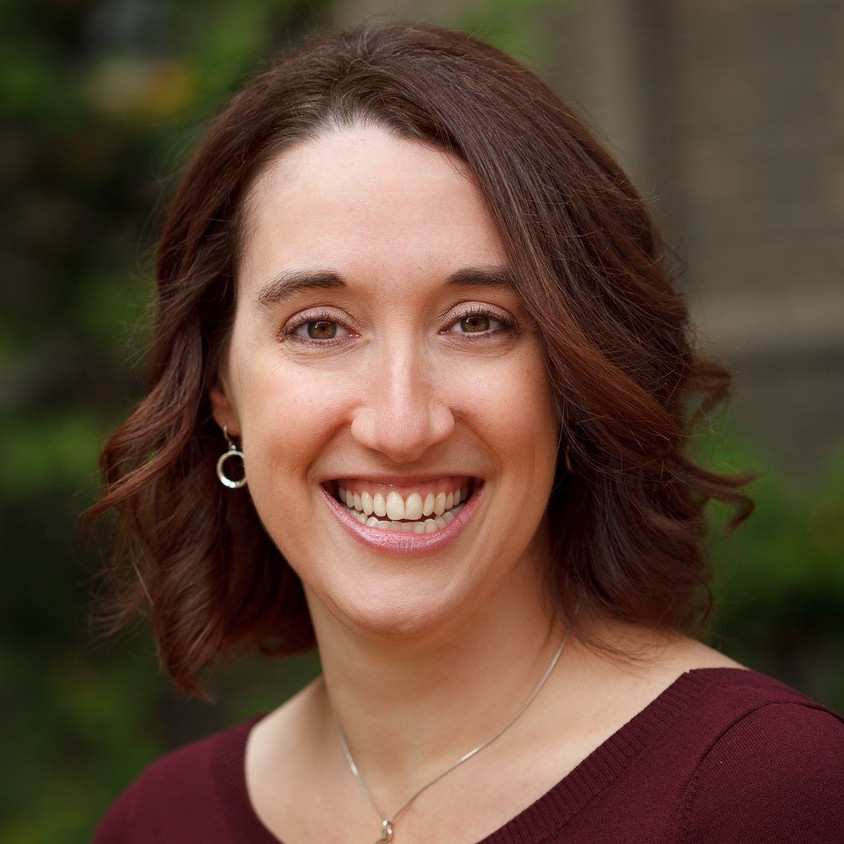The first time I saw Meryl McMaster’s work was in the spring of 2022. The Ottawa-based artist was one of 12 Indigenous artists from the Arctic region exhibiting in the House of Sweden, the building on Washington, D.C.’s Georgetown waterfront that serves as the country’s embassy. Her contributions to the exhibit were enormous photographic prints — self-portraits, with dramatic costumes, set in vast, expansive and remote landscapes, the kind of art that can almost be stepped into, and the kind that leaves an impression even when they’re out of sight.
McMaster herself seems both lost in the environment, and crafted from it, which is the entire point.
Her photographs and sculptures — now on display at a solo exhibit at the Embassy of Canada and a group show at the National Museum of Women in the Arts — also strive to explore her conflicting sense of identity as a Canadian with Nêhiyaw (Plains Cree), British and Dutch lineage.
In a conversation with The Revelator, McMaster spoke of her process, her connection to the landscape, and her evolution as an artist, as well as what advice she has for people pursuing creative paths that might scare them.
Your work has this very ethereal, visceral quality. It has both a very soft, dreamy edge, but also a sharp impact. What do you want folks to leave with the experience of viewing one of your exhibits?
I really welcome the viewer to engage with the work, sometimes just as simply as using their imagination to fill in the blanks, and travel in this quick moment that they have with the work, and this own storyline in their own head.
On a simpler level, it’s just also having this moment, to escape, and forget the outside world.
I’d want them to think about our connections to each other, and also our disconnections from our cultures, and explore in their head the wonderment of these really immersive landscapes.
I just think of our natural world, and just how in awe of it I am, and how small we are in this natural world, and how it’s so important to think about protecting these spaces that we all live in.
Also I’d like them to think about how I’m representing, in these photographs, the generations before us and what these previous generations have sacrificed, and went through, in order for us to be in these spaces, and places today.
These are vastly panoramic landscapes that you’re working in, with very elaborate designs. What goes into staging your photographs?
(laughs) It’s definitely a process that’s taken many years to nail down, because it’s tricky. In a lot of cases, I have to hike into some of these locations. I don’t have a huge team that works with me. It’s usually friends or family, depending on where I’m photographing. So with the help of one or two other people, I’m carrying in the objects you’re seeing in these photographs. I try to keep my camera kit very small. I’m not taking lights or anything like that.
I’m usually up early because I’m photographing a lot in the morning, or in those golden hours.
It’s a lot of research into these site-specific locations, looking at historical photographs. When I get to these sites, I’m usually there for a couple days, to allow for contingency, for weather. A lot of times, I’m dealing with some tricky weather, high winds especially, although you can’t see that in the photograph.
View this post on Instagram
It’s a lot to prepare for, even just mentally and physically. It’s physically draining afterwards. Sometimes I’m photographing in the middle of winter, so it’s quite cold. Being the photographer, being the one that’s thinking about all the technical aspects, as well as also being the subject, and thinking about how to kind of get across that narrative through the image — it’s definitely not easy.
You’ve spoken previously of the conflicts between your Euro-Canadian and Indigenous identities. Why do you focus on these issues, and how do they manifest in your work?
From a really young age, I was aware of my different backgrounds, and knowing about my ancestry, family history, and stories. I was really interested in getting to know, and imagine, who those families were. That grew into learning about our broader history and how it went from these smaller family stories to these broader, more complex relationships that my ancestors had. That got me really curious, and it started to create these questions about my belonging and identity to these very different histories and cultures. Then, when I was trying to figure out what was I going to explore as an artist, I really wanted to do something that I could relate to, and, coming from a very personal place, something that I could speak to from my own personal experience.
That’s where I really gravitated toward exploring this complexity of family, and kin, and looking at this bicultural heritage of mine. I was thinking about these fuzzy edges of these multiple histories and thinking about time and memory, and those complex questions. I’m trying to create, through this influence of storytelling, these magical moments, these narratives that look at actual events and experiences mixed with these imagined experiences, in order to draw the viewer in, in a different way, to start to think about these conversations, and these harder histories that we all share.
View this post on Instagram
Meryl, your first professional exhibit was in 2010. How has your work as an artist grown from your first exhibition to now, when you’re exhibiting across Washington and around the world? How do you see that evolution?
Well, I didn’t expect [to be] exploring personal and direct family stories. In my earlier works, I was working more broadly with historical events, not working with site-specific locations, partly just because of budget. I was working in and around where I lived, and the costumes maybe weren’t as elaborate as what I do now, or the objects. My abilities to create the different elements within the images has grown a lot.
You know, I still in a lot of ways feel like this emerging artist, and when I think back, it’s just amazing how time flies, and all the ideas that I have explored over my work, it’s interesting to see them evolve, and maybe become more deeper, more enriched through time.
Because of grants, I’m able to travel to site-specific locations that influence the ideas that I’m working with, to travel to these places, and also back to where my family’s from in Saskatchewan. And I can see how my work has grown as a result.
View this post on Instagram
What advice do you have for other artists as they’re choosing subjects and themes — things that maybe are a little bit more intimate than they want, or comfortable with, or a little bit scarier, a bit of a stretch — about stepping into that space?
To really inspire, I think it has to come from something that you’re really passionate about, and interested in exploring, and lending your voice to. If you’re just really interested and passionate about exploring certain questions and ideas, I think that will shine through in the works.
Try not to listen to too many outside voices. Follow your gut as much as possible. I think something that I’ve trusted more over the years, as I’ve evolved as an artist, is just when something doesn’t feel right, don’t be afraid to pivot. When an idea is not working out for me, or a sculpture’s not working out for me, sometimes it’s heartbreaking to have to start from scratch. But taking those risks and trusting yourself, that’s part of the creative process of an artist.
Letting there be that freedom for ideas to just change and evolve, I think, is something that takes a bit of the pressure off and also puts more kind of excitement and joy into that process. I think just as a young artist, just don’t feel like you have to finish the idea at the beginning. Start experimenting and let those ideas evolve.
As an artist you express yourself through your photography and your work, and you’ve been written about over the years in different capacities. What do you want people to know about you and your work that hasn’t already been put out there?
Within my work, it’s almost like this different side of me that you see that maybe you wouldn’t when we’re just talking normally. When I make these images, it gives me a different kind of confidence, or maybe kind of different outlook on the world. I take my time with these images to have these feelings, and even these insecurities, these harder questions, that I put into this work.
Meryl McMaster’s exhibit, “On the Edge of This Immensity,” will be on display at the Embassy of Canada’s art gallery through the summer. The National Museum of Women in the Arts’ “Women to Watch” exhibit will be on display through August 11. Additional events are listed on her website. Follow her on Instagram and Facebook.



